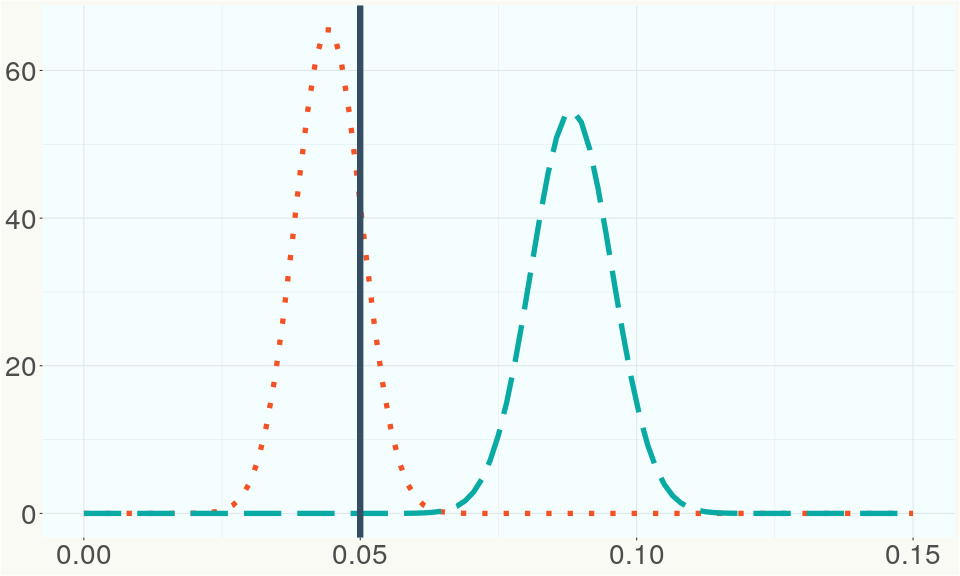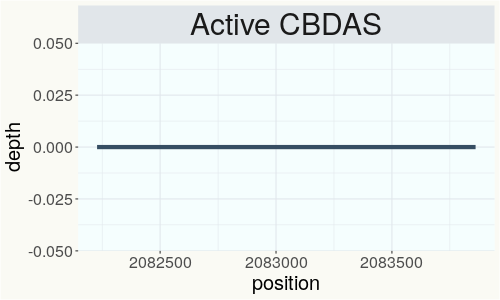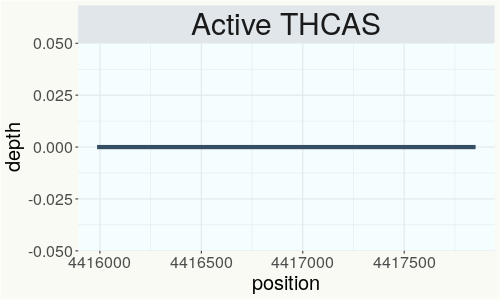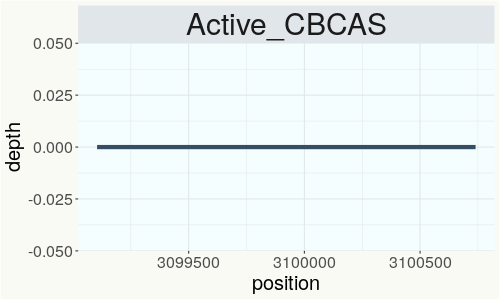Santhica 27
RSP 10665
Grower: CSU
General Information
- Sample Name
- Santhica 27 5
- Accession Date
- February 14, 2017
- Reported Plant Sex
- Female
- Report Type
- StrainSEEK v2 3.2Mb
- DNA Extracted From
- Leaf
The strain rarity visualization shows how distant the strain is from the other cultivars in the Kannapedia database. The y-axis represents genetic distance, getting farther as you go up. The width of the visualization at any position along the y-axis shows how many strains there are in the database at that genetic distance. So, a common strain will have a more bottom-heavy shape, while uncommon and rare cultivars will have a visualization that is generally shifted towards the top.
Chemical Information
Cannabinoid and terpenoid information provided by the grower.
Cannabinoids
No information provided.
Terpenoids
No information provided.
Genetic Information
- Plant Type
- Type IV
File Downloads
The bell curve in the heterozygosity visualization shows the distribution of heterozygosity levels for cannabis cultivars in the Kannapedia database. The green line shows where this particular strain fits within the distribution. Heterozygosity is associated with heterosis (aka hybrid vigor) but also leads to the production of more variable offspring. When plants have two genetically different parents, heterozygosity levels will be higher than if it has been inbred or backcrossed repeatedly.
The ratio of reads mapped to Y-contigs to reads mapped to the whole Cannabis genome (Y-ratios) has been demonstrated to be strongly correlated with plant sex typing. This plot shows the distribution of Y-ratios for all samples in our database which were sequenced with the same method (panel or WGS) as this sample and where this sample falls in the distribution.

This chart represents the Illumina sequence coverage over the Bt/Bd allele. These are the three regions in the cannabis genome that impact THCA, CBDA, CBGA production. Coverage over the Active CBDAS gene is highly correlated with Type II and Type III plants as described by Etienne de Meijer. Coverage over the THCA gene is highly correlated with Type I and Type II plants but is anti-correlated with Type III plants. Type I plants require coverage over the inactive CBDA loci and no coverage over the Active CBDA gene. Lack of coverage over the Active CBDA and Active THCA allele are presumed to be Type IV plants (CBGA dominant). While deletions of entire THCAS and CBDAS genes are the most common Bt:Bd alleles observed, it is possible to have plants with these genes where functional expression of the enzyme is disrupted by deactivating point mutations (Kojoma et al. 2006).



This chart represents the Illumina sequence coverage over the CBCA synthase gene.

Variants (THCAS, CBDAS, and CBCAS)
No variants to report
Variants (Select Genes of Interest)
| PKSG-2b | c.31A>T | p.Thr11Ser | missense variant | moderate | contig700 | 1951851 | T/A | |
| PKSG-4b | c.496A>G | p.Lys166Glu | missense variant | moderate | contig700 | 2721177 | T/C | |
| PKSG-4b | c.489delT | p.Phe163fs | frameshift variant | high | contig700 | 2721183 | CA/C | |
| PKSG-4b | c.485A>G | p.Lys162Arg | missense variant | moderate | contig700 | 2721188 | T/C | |
| aPT1 |
c.95_97delGT |
p.Cys32del | disruptive inframe deletion | moderate | contig121 | 2835800 | ATGT/A | |
| aPT1 | c.406A>G | p.Ile136Val | missense variant | moderate | contig121 | 2839605 | A/G |
Nearest genetic relatives (All Samples)
- 0.113 Santhica27 (RSP10056)
- 0.124 Santhica27 (RSP11046)
- 0.128 Santhica27 (RSP11047)
- 0.147 Santhica 27 (SRR14708211)
- 0.155 Beniko (SRR14708275)
- 0.156 USO31 (RSP10233)
- 0.163 Fedora 17 (RSP10661)
- 0.173 Fedora 17 (SRR14708222)
- 0.176 R1in136 (SRR14708237)
- 0.177 Juso14 (SRR14708259)
- 0.180 VIR 223 - Bernburgskaya Odnodomnaya - bm (SRR14708217)
- 0.182 USO 31 (RSP10983)
- 0.182 Ferimon 12 (SRR14708233)
- 0.184 Tygra (RSP10667)
- 0.185 R1in136 (SRR14708227)
- 0.185 Lovrin (RSP10658)
- 0.185 Bialobrzeskie (SRR14708244)
- 0.187 KYRG-151 (RSP11052)
- 0.187 R1in136 (SRR14708226)
- 0.188 Diana (RSP10235)
Most genetically distant strains (All Samples)
- 0.432 Cherry Blossom (RSP11311)
- 0.419 Cherry Blossom (RSP11301)
- 0.415 Cherry Blossom (RSP11298)
- 0.410 Cherry Blossom (RSP11323)
- 0.407 Cherry Blossom (RSP11312)
- 0.406 Chem 91 (RSP11185)
- 0.404 Unknown--Cherry Wine---001- (RSP11268)
- 0.401 Cherry Blossom (RSP11318)
- 0.400 Cbot-2019-005 (RSP11133)
- 0.397 Cherry Blossom (RSP11334)
- 0.395 Fatso (RSP11741)
- 0.395 Cherry Blossom (RSP11328)
- 0.394 Escape Velocity (RSP11165)
- 0.393 JL x NSPM1 4 (RSP11482)
- 0.393 Danny Noonan (RSP11070)
- 0.393 Lemon Skunk (RSP11229)
- 0.392 Cherry Blossom (RSP11308)
- 0.392 Cherry Blossom (RSP11335)
- 0.390 Cherry Blossom (RSP11309)
- 0.389 AVIDEKEL 2 0 (RSP11174)
Nearest genetic relative in Phylos dataset
- Overlapping SNPs:
- 81
- Concordance:
- 57
Nearest genetic relative in Lynch dataset
- Overlapping SNPs:
- 6
- Concordance:
- 5
Blockchain Registration Information
- Transaction ID
-
f36658c4e7ffc71d
23f1d8981780a854 d0d912381b56984b 4bb60bd191b309d4 - Stamping Certificate
- Download PDF (857.6 KB)
- SHASUM Hash
-
83baf8f04280f85b5bb2193e6ff646fb 6aaa71d8e24a98c2 e34c60e1122e9ab1